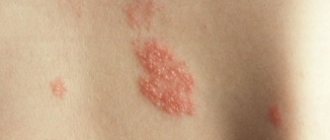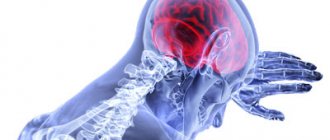Diabetic neuropathy is a complication of diabetes that causes damage to the nervous system. This is a progressive disease and symptoms get worse over time.
Neuropathy occurs when high levels of cholesterol or blood sugar damage nerves in the body, causing various symptoms.
Nerves coordinate the work of the entire body. They allow people to move, send messages about how they are feeling, and control automatic functions such as breathing.
Neuropathy is found in 1/3 to 1/2 of patients with diabetes, according to the National Institute of Diabetes and Digestive and Kidney Diseases (NIDDK).
In this article, we will look at the different types, effects, and risks of diabetic neuropathy.
What is diabetic neuropathy
Diabetic neuropathy
is a combination of syndromes affecting various parts of the peripheral and autonomic nervous system, which occurs against the background of metabolic disorders in diabetes mellitus and complicates its course.
According to statistics, being one of the most common and serious complications of diabetes, various forms of diabetic neuropathy are diagnosed in almost half of all patients with diabetes.
Diabetic neuropathy is characterized by signs of impaired conduction of nerve impulses, sensitivity, as well as various disorders of the somatic and autonomic nervous systems that arose when other causes and factors of nervous system dysfunction (trauma, infections, etc.) were excluded. The clinical manifestations of the disease are very diverse, so most doctors with a narrow specialization encounter diabetic neuropathy - neurologists, urologists, endocrinologists, gastroenterologists, dermatologists, etc.
Treatment of neuropathic pain in diabetic polyneuropathy
Patients with diabetes may develop various forms of painful diabetic neuropathy, which differ in the localization of pain, severity of occurrence and nature of pain, although in all cases the pain is neuropathic (Table 1). The classic variant of peripheral neuropathic pain is the pain syndrome associated with diabetic distal symmetrical sensory-motor polyneuropathy. Epidemiological studies conducted in the USA have shown that neuropathic pain occurs with diabetic polyneuropathy more often than with all polyneuropathies of other etiologies combined. According to the Russian EPIC study, neuropathic pain in diabetic polyneuropathy is second only to back pain in prevalence. Diabetic polyneuropathy (DPN) occurs in approximately 50% of patients with diabetes, while neuropathic pain occurs in 11–24% of patients with polyneuropathy, depending on the duration of diabetes and polyneuropathy, as well as the type of diabetes. Already during the first description of a patient with DPN in 1798, the English physician J. Rollo identified pain and paresthesia as the main symptoms. Clinical manifestations, frequency, severity and duration of pain in DPN are very diverse; they are united by a common feature - the neuropathic nature of pain. Among patients suffering from diabetes, chronic pain occurs in 25% of cases, while in the population the prevalence of chronic pain syndromes is about 15%, and the difference is formed to a greater extent due to neuropathic pain. Neuropathic pain in DPN is represented by two main components: spontaneous (stimulus-independent) and evoked (stimulus-dependent) pain. Spontaneous pain can be constant (burning pain) or occur paroxysmally with pain lasting from seconds to hours (shooting pain). Spontaneous pain is caused by the ectopic activity of nociceptive C-fibers as a result of the appearance on them under pathological conditions of a large number of sodium channels and a change in the excitability of pain receptors, leading to their activation under low-threshold stimuli, which is not observed under normal conditions. It is also possible that excitation is transferred from one fiber to another - the phenomenon of ephaptic excitation. Thus, pain afferentation increases, further leading to changes in the excitability of nociceptive neurons of the dorsal root ganglion and dorsal horn. The processes of disruption of the functional state of dorsal horn neurons associated with the mechanisms of ambient pre- and postsynaptic inhibition, deafferentation, as well as the mechanisms of central sensitization with damage to peripheral nerves are described in detail in reviews by foreign and domestic authors. Nociceptive signals from dorsal horn neurons travel to the thalamus opticum and then to the somatosensory cortex, where pain is perceived. It has been shown that, unlike patients with diabetes mellitus without pain, patients with painful DPN undergo a change in metabolism in the thalamus. Neurons of central sensory structures can also change their excitability with the formation of the phenomenon of sensitization. All central structures for the conduction and perception of pain have close connections with descending inhibitory and activating pathways. The main inhibitory (antinociceptive) influences are associated with descending pathways from the periaqueductal gray matter and the rostro-ventral parts of the medulla oblongata to the dorsal horn. These descending inhibitory influences are realized through the norepinephrine and serotonin neurotransmitter systems. In clinical practice, diagnosing the neuropathic nature of pain is often difficult. The experience of pain is always subjective, it cannot be accurately measured, and there are no absolute criteria to distinguish neuropathic pain. Judging the pathophysiological mechanisms underlying the pain syndrome can only be tentative, based on the characteristics of pain, data from a neurological examination and the results of a neurophysiological study. Moreover, the identification of clinical signs and changes in electrophysiological parameters showing a pathological change in the state of the nociceptive system does not reliably prove the presence of neuropathic pain. Neuropathic pain can occur immediately after damage to the nociceptive system (for example, in acute small fiber neuropathy in diabetes), or it can develop years or even decades after damage (for example, in DPN). The neuropathic nature of pain can be diagnosed if a dysfunction of the nociceptive system is confirmed in the presence of: 1) spontaneous sensory symptoms; 2) the results of a clinical examination identifying symptoms of damage to the nervous system: positive neuropathic symptoms (stimulus-dependent pain) and negative neuropathic symptoms (neurological deficit); 3) data from neurophysiological studies (EMG, quantitative sensory testing, somatosensory evoked potentials). In this case, the choice of research methods is determined by the results of a neurological examination. Neurological symptoms make it possible to determine the presence, extent and localization of damage to the nervous system. To diagnose the phenomenon of neuropathic pain, the doctor is primarily interested in the state of the sensory system. It is clear that, depending on the peripheral or central localization of the pathological process, a study of the general neurological status, including the motor and autonomic systems, is of great importance for diagnosis. In this case, negative symptoms will include, for example, decreased reflexes, muscle strength, the presence of muscle atrophy, dryness and discoloration of the skin. When identifying damage to the sensory system, to diagnose neuropathic pain, they focus on the state of sensitivity associated with the activation of thin, weakly myelinated A- (cold stimuli and blunt prick) and thin, unmyelinated C- fibers (painful and thermal stimuli). It should be remembered that neuropathic pain usually occurs in the area of decreased or lack of sensitivity, that is, the area of pain and sensitivity disorders in these cases coincides. In recent years, epidemiological studies to study the prevalence of pain are based on the use of special questionnaires that make it possible to determine the nature of pain with a high degree of accuracy. Treatment of neuropathic pain is based on modern ideas about the pathophysiological mechanisms of its development. Pharmacological interventions are used aimed at reducing peripheral afferentation, which supports changes in the excitability of nociceptive structures of the spinal cord and brain, drugs that reduce the excitability of nociceptive neurons, and drugs that enhance supraspinal descending inhibitory antinociceptive effects. In severe cases, administration of pharmacological drugs close to the central receptors (intradural) is used. It is possible to use electrical stimulation of peripheral nerves, primarily proprioceptive fibers, to enhance the inhibitory effects on the excitability of nociceptive neurons of the spinal cord, and acupuncture. Surgical treatment for cases refractory to pharmacotherapy may include the use of implanted electrodes in the brain or spinal cord, nerve release or decompression, chemical destruction, or nerve transection. Table 2 presents recently published Russian recommendations for the diagnosis and treatment of neuropathic pain, prepared by a group of leading experts in the field of pain treatment and published under the editorship of Academician of the Russian Academy of Medical Sciences, Professor N.N. Yakhno. As can be seen from Table 2, from the point of view of evidence-based medicine, the use of 4 classes of drugs for the treatment of NB is most justified: anticonvulsants, antidepressants, opioid analgesics and local anesthetics. The use of local anesthetics leads to a reduction in neuropathic pain, especially in cases where its development is primarily due to pathological changes in the peripheral nerves. However, local anesthetics in the form of patches are not recommended for long-term use or if the affected area is large enough. Antidepressants are widely used in the treatment of neuropathic pain of various etiologies. Tricyclic antidepressants (TCAs), which have been used since the 1950s, most notably amitriptyline, are highly effective for neuropathic pain. In diabetic painful polyneuropathy, in more than 80% of cases, their administration reduces pain or leads to its disappearance. The main mechanism of action of TCAs is to block the reuptake of norepinephrine and serotonin into the presynaptic terminal through their action on sodium and calcium channels, which leads to increased activity of central antinociceptive structures. Selective serotonin reuptake blockers (paroxetine, fluoxetine) do not act on postsynaptic receptors and therefore have fewer side effects, but their ability to reduce neuropathic pain is significantly inferior to TCAs. Amitriptyline has been studied in a few controlled studies for painful diabetic polyneuropathy. The standard dose of amitriptyline to start treatment with is 25 mg, the usual therapeutic range of the drug is 75–150 mg. TCAs are limited in use for neuropathic pain, especially in older patients, due to numerous and sometimes severe side effects. Orthostatic hypotension, urinary retention, constipation, tachycardia, and “dry syndrome” can occur not only in older people. The presence of glaucoma and prostate adenoma are contraindications for the use of TCAs. In addition, long-term use of TCAs has been shown to increase the risk of myocardial infarction by 2.2 times. Additional disadvantages of amitriptyline include nonlinearity of pharmacokinetics, that is, when taking small doses, the concentration of the substance in plasma may be higher than when taking large doses. Anticonvulsants have been used to treat pain syndromes since the 40s of the 20th century, when the effectiveness of phenytoin in the treatment of trigeminal neuralgia was shown. In 1962, the anticonvulsant carbamazepine, similar in structure to TCAs, was first used to treat trigeminal neuralgia, which remains the first-line drug in the treatment of trigeminal neuralgia to this day. Gabapentin, an anticonvulsant that appeared in the 90s of the 20th century, has proven itself to be an effective drug for the treatment of neuropathic pain of various etiologies. Gabapentin is close in structure to g-aminobutyric acid (GABA). The effectiveness of the original gabapentin (Neurontin) was shown in double-blind, placebo-controlled studies in cases of neuropathic pain in patients with diabetic polyneuropathy. However, it should be remembered that the optimal therapeutic dose of gabapentin for the treatment of NB is 1800–2400 mg, the drug must be titrated over 2 weeks, which makes it very inconvenient to take. Of the latest generation of anticonvulsants, which have been studied in recent years in the treatment of neuropathic pain, attention is drawn to pregabalin (Lyrica pharmaceutical), which has currently taken first place among the drugs used to treat neuropathic pain syndrome in DPN. Pregabalin (Lyrica), according to Russian recommendations for the treatment of NB, is the first-line drug for the treatment of NB in DPN. 10 randomized, double-blind, placebo-controlled studies were conducted, mainly in painful diabetic polyneuropathy and postherpetic neuralgia, which involved almost 10,000 patients. Pregabalin has been shown to be highly effective for all neuropathic pain. Suffice it to say that pregabalin is registered in the USA and Russia as a drug for the treatment of all types of neuropathic pain. Pregabalin has a unique mechanism of action – it modulates neuronal activity. Pregabalin binds to the a2-delta protein of voltage-dependent calcium channels on the presynaptic membrane and reduces the entry of calcium into the cytoplasm. This leads to a decrease in the release of neurotransmitters, primarily the excitatory transmitter glutamate, which leads to a decrease in the excitability of dorsal horn neurons. Moreover, pregabalin has this effect predominantly on hyperexcited neurons. An important advantage of pregabalin is its pharmacokinetics. It is very quickly absorbed from the intestine, reaching a maximum concentration in the blood within one hour and remains in the blood for a long time in high concentration, which allows the drug to be prescribed 2 times a day in equal doses. Over the entire range of therapeutic doses (from 150 to 600 mg), pregabalin has linear pharmacokinetics, which is not observed with other drugs, including gabapentin. Pregabalin has a very high bioavailability (90%), superior to gabapentin (60%) in this regard. Food intake does not affect the bioavailability of the drug. Treatment usually begins with a dose of 75 mg 2 times a day, then after 3 days, the dose must be increased to 300 mg per day. Studies have shown that pregabalin significantly reduces the intensity of neuropathic pain during the first three days of taking the drug. Such a high effectiveness of pregabalin in relieving NB sets it apart from the previous generation of anticonvulsants, such as gabapentin. Long-term studies (15 months) of the use of pregabalin for neuropathic pain showed that it retains its analgesic effect throughout the entire period of use without developing tolerance to the drug. The excellent analgesic effect of pregabalin is confirmed by improvements in sleep, mood and quality of life in patients. Pregabalin is well tolerated in patients with neuropathic pain. The most common side effects are increased drowsiness and dizziness, which usually disappear fairly quickly (2–4 weeks), even if the patient continues to take the drug or increases its dose. Due to the fact that the drug is not metabolized in the liver, does not interact with the cytochrome P450 system and is excreted by the kidneys as an unchanged molecule, it does not have hepatotoxicity. The drug does not act on renal tissue and does not cause kidney pathology, so it can be used in patients with renal pathology, however, the dose of the drug in this case should be selected according to the instructions. Pregabalin does not interact with other drugs and can be used in various combinations, for example with antidiabetic drugs. In clinical studies, pregabalin has been shown to be highly effective in treating neuropathic pain caused by diabetic peripheral nerve damage. Thus, in a randomized, double-blind, placebo-controlled study in 146 patients with painful DPN, a significant reduction in the intensity of neuropathic pain was obtained within the first week of the study, which was maintained over the next 8 weeks of taking the drug. A graded visual analogue Likert scale was used as the main criterion in the study. There was also a significant improvement in the sleep and social abilities of patients. Another study on 81 patients showed that when other pharmacological drugs were ineffective for painful diabetic polyneuropathy, pregabalin at a dose of 150–600 mg was significantly effective. Thus, modern pharmacological drugs, primarily pregabalin, used in the treatment of neuropathic pain in patients with DPN make it possible, using them as monotherapy or in combination, to reduce pain in most patients and significantly improve their quality of life.
Literature 1. Pain syndromes in neurological practice. Edited by A.M. Vane - M. - 2001 2. Bone M, Critchley P, Buggy DJ Gabapentin in postamputation limb pain: a randomized, double-blind, placebo-controlled, cross-over study // Reg Anesth Pain Med - 2002 – Vol.27 – P. 481–486. 3. Kukushkin M., L., Khitrov N.K. General pathology of pain // M. – 2004 – 144 pp. 4. Cohen HW, Gibson G., Alderman MH Excess risk of myocardial infarction in patients treated with antidepressant medication. Association with the use of tricyclic agents // Am J Med – 2000 – Vol.108 – P.2–8. 5. Backonja M. Anticonvulsants and antiarrhythmics in the treatment of neuropathic pain syndromes // In Neuropathic Pain: Pathophysiology and Treatment. Ed. Hansson PT – Seattle, IASP Press – 2001 – P.185–201. 6. Rose MA, Kam PCA Gabapentin: pharmacology and ist use in pain management // Anaesthesia – 2002 – Vol.57 – P.451–462. 7. McLean MJ, Morell MJ, Willmore LJ et al. Safety and tolerability of gabapentin as adjunctive therapy in a large, multicenter study // Epilepsia – 1999 – Vol.40 – P. 965–972. 8. Bakonja M. Gabapentin monotherapy for the symptomatic treatment of painfuk neuropathy: a multicenter, double–blind, placebo–controlled trial in patients with diabetes mellitus // Epilepsia – 1999 – Vol.40 (Suppl.6) – P.57– 59. 9. Singh D., Kennedy D. The use of gabapentin for the treatment of postherpetic neuralgia // Clin Ther - 2003 - Vol.25 - P.852–889. 10. Cheshire W. Defining the role for gabapentin in the treatment of trigeminal neuralgia: a retrospective study // J.Pain – 2002 – Vol.3 – P.137–142. 11. Solaro C., Ucelli A., Inglese M. et al. Gabapentin is effective in treating paroxysmal symptoms in multiple sclerosis // Neurology – 1998 – Vol.50 (Suppl.4) – P.A147. 12. Attal N., Cruccu G., Haanpaa M. et al. EFNS guidelines on pharmacological treatment of neuropathic pain // European Journal of Neurology – 2006 – Vol.13 – P.1153–1169. 13. Rosenstock J., Tuchman M., LaMoreaux L. et al. Pregabalin for the treatment of painful diabetic peripheral neuropathy/ A double-blind placebo-controlled trial // Pain – 2004 – Vol.110 – P.628–638. 14. Sabatowski R., Galevz R., Cherry DA et al. Pregabalin reduced pain and improves sleep and mood disturbances in patients with post–herpetic neuralgia. Results of a randomized, placebo-controlled clinical trial // Pain – 2004 – Vol.109 – P. 26–35. 15. Yakhno N.N., Kukushkin M.L., Davydov O.S. and others. Results of a Russian epidemiological study of the prevalence of neuropathic pain, its causes and characteristics in a population of outpatients who consulted a neurologist // Pain - 2008 - No. 3 - pp. 24–32. 16. Danilov A.B., Davydov O.S. Neuropathic pain // From Borges, Moscow – 2007 – pp. 32–55. 17. Chan AW, MacFarlane IA, Bowsher DR et al. Chronic pain in patients with diabetes mellitus: comparison with non-diabetic population // Pain Clinic – 1990 – No. 3 – P.147–159. 18. Novikov A.V., Solokha O.A. Neuropathic pain: Review based on materials from the journal “The Lancet” (May–June 1999) // Neurological Journal – 2000– No. 1 – pp. 56–61. 19. Besson J. The neurobiology of pain // Lancet – 1999 – Vol.353 – P.1610–1615. 20. Sorensen L, Siddall PJ, Trenell MI et al. Differences in metabolites in pain–processing brain regions in patients with diabetes and painful neuropathy // Diabetes Care – 2008 – Vol.31 – P.980–981. 21. Stacey BR, Dworkin RH, Murphy K. et al. Pregabalin in the treatment of refractory neuropathic pain: results of a 15–month open–label trial // Pain Med – 2008 Mar 11. 22. Jann MW, Slade JH Antidepressant agents for the treatment of chronic pain and depression // Pharmacotherapy – 2007 – Vol.27 –P.1571–1587. 23. Guidelines for the diagnosis and treatment of neuropathic pain. Edited by Academician of the Russian Academy of Medical Sciences N.N. Yakhno //Moscow, Publishing House of the Russian Academy of Medical Sciences – 2008 – 32 pages.
Causes and mechanisms of development of diabetic neuropathy
The main cause of diabetic neuropathy is chronically elevated blood glucose levels.
, ultimately leading to changes in the structure and functioning of nerve cells.
Due to impaired carbohydrate metabolism in diabetes mellitus, patients develop microangiopathies
- pathological changes in the vessels of the microvasculature, due to which the normal blood supply to the nerves is disrupted. As a result of multiple metabolic disorders, swelling of the nervous tissue develops, all metabolic processes in the nerve fibers are disrupted, the conduction of nerve impulses deteriorates, the antioxidant system is inhibited, leading to the accumulation of free radicals that have a detrimental effect on nerve cells, the production of autoimmune complexes begins, which ultimately can lead to atrophy of nerve fibers.
There are a number of factors that increase the risk of developing diabetic neuropathy:
- old age;
- long history of diabetes mellitus;
— decompression phase;
- increased blood pressure;
- overweight and obesity;
- smoking, drinking alcoholic beverages.
Treatment of diabetic polyneuropathy
It is worth considering that for successful treatment of diabetic polyneuropathy it is necessary to keep blood sugar at a normal level. Although this is not an absolute guarantee that the disease will not develop further, since there are other risk factors, which include:
- patient's age;
- body weight to height ratio;
- frequency of alcohol consumption;
- smoking.
During treatment of the disease, it is necessary to inspect the feet daily and prevent the possibility of damage to the skin. For this it is recommended:
- wear soft, comfortable, loose shoes;
- do not walk on the floor barefoot;
- If there are skin lesions, consult a doctor or use healing medications prescribed by your doctor.
Dry skin with cracks must be cleansed and treated with special creams every day.
If the first symptoms of the disease are detected, you should urgently contact a therapist for a comprehensive study. If polyneuropathy is suspected, it should be taken into account that the affected nerve tissues do not recover, which is why it is so important to diagnose and prescribe treatment in a timely manner. At the moment, vitamin complexes and drugs from the group of antihypoxants are actively used among drug therapy methods. Physiotherapeutic treatments are also common.
It is worth remembering that the course of treatment should be complex and mixed. It necessarily includes certain groups of drugs aimed at all areas of process development. It is most important that the treatment of diabetic polyneuropathy includes taking medications, including:
- vitamins. They must be supplied with food, but during the course of the disease the rate and quantity of their absorption decreases. Therefore, an additional reception is necessary. Thanks to vitamins, the transmission of impulses along nerve fibers improves, and they also block the negative effect of glucose on the nervous system;
- painkillers;
- antibiotics. Necessary only when there may be a risk of developing gangrene. To prevent tissue damage, it is better to destroy the infection in advance;
- aldose reductase inhibitors. The substance interferes with one of the pathways for transforming glucose in the blood, thereby reducing its harmful effects on nerve endings;
- antihypoxants. They promote the use of glucose in the body, improve blood circulation in the capillaries, arteries and veins that feed nerve cells, and also prevent the death of nerves.
The attending physician prescribes qualified treatment based on what particular form of diabetic polyneuropathy is detected. Properly selected therapy completely relieves the symptoms of the disease and ensures a complete cure. An experienced specialist recommends not only medication, but also non-drug treatment.
The most important task is to reduce the level of sugar in the blood plasma, and only then can you begin to treat the disease. If this is not done, then all therapy will be ineffective.
In case of a toxic form of diabetic polyneuropathy, you should completely avoid alcoholic beverages and follow a strict diet. The attending doctor must prescribe special medications that improve blood microcirculation in the body and prevent thrombosis. Additionally, medications that relieve swelling may be prescribed. All medications are selected by specialists based on each individual case, so you should not focus your treatment on other patients with the same disease.
During treatment, the patient must be provided with the most comfortable conditions and supported in everything in everyday life. It is equally important to ensure complete safety even in small things. For example:
- control the temperature of the water in the bathroom to prevent skin burns;
- clean shoes regularly and check their integrity;
- protect the feet from excessive compression;
- Check daily the integrity of the skin, which can be damaged by objects falling inside the shoes or by compression.
Diabetic neuropathy - symptoms, syndromes, types
Diabetic neuropathy is classified in several ways. A number of authors distinguish four main types of diabetic neuropathy:
— peripheral neuropathy
- one of the most common types, in which there is damage to the nerve fibers of the extremities, and the lower extremities are affected more often;
— autonomic neuropathy
- in which the functioning of many internal organs is disrupted - the heart, stomach, intestines, and sexual dysfunction develops;
— proximal neuropathy
- characterized by severe pain in the thighs, buttocks and hip joints;
— focal neuropathy
- in which local damage to individual nerve fibers occurs.
There is a classification of diabetic neuropathy, which is based on the principle of identifying syndromes with characteristic clinical manifestations and course. According to it, diffuse neuropathy
(affecting all nerve fibers) and
focal neuropathy
(affecting certain areas of the human body).
The prevalence of diffuse neuropathy is much higher, it progresses rapidly and is often asymptomatic. It includes autonomic diabetic neuropathy
and
distal symmetric sensorimotor diabetic polyneuropathy
.
Focal neuropathy is less common and occurs acutely, losing its clinical manifestations over time. It includes cranial neuropathy, radiculopathy, plexopathy, mononeuropathy.
3.Symptoms
There are several clinical forms of diabetic polyneuropathy. In some cases, the syndrome manifests itself decades after the main diagnosis, in others, on the contrary, it turns out to be one of the first manifestations of diabetes mellitus.
With early onset of polyneuropathy, as a rule, sensitivity to vibration decreases and some reflexes are weakened. In the case of acute damage to the femoral, ulnar, trigeminal, sciatic and other nerves, disturbances in general tactile sensitivity develop, and partial paralysis is noted in the muscle groups associated with the affected nerve. The third, actually polyneuropathic option consists of multiple lesions of the nerves of the extremities, especially the lower ones, and is characterized by rest pain, a painfully aggravated reaction to heat, a tendency to mummification of the skin, the formation of trophic ulcers and gangrenous necrosis due to gross disturbances of tissue nutrition; Often there is concomitant inflammation and deformation of the joints (“diabetic foot”). Many patients describe, along with pain, itching or burning sensations, various kinds of paresthesia (illusory sensations, for example, “electrical discharges”), and muscle weakness.
As a rule, diabetic polyneuropathy occurs with a gradual worsening of symptoms. The most severe complications develop when the innervation system of internal organs, as well as the oculomotor nerve, is involved.
The diagnosis is established mainly clinically, using specially developed criteria and scales, reflexological research methods, analysis of anamnestic information and subjective complaints. Of the instrumental diagnostic methods, electroneuromyography, somatosensory evoked potentials, electrocardiography, etc. are of greatest importance.
About our clinic Chistye Prudy metro station Medintercom page!
Peripheral neuropathy
Peripheral diabetic neuropathy occurs predominantly in the lower extremities and is characterized by burning and painful sensations in the legs, often occurring at night, a feeling of sudden heat or cold, and pins and needles in the legs. Patients are very sensitive to touch, sometimes it is even painful. Deformations of the muscles of the limbs may be observed. Any damage. violating the integrity of the skin of the extremities become wounds that do not heal over a long period.
Causes
In most cases, sensory polyneuropathy of the lower extremities develops due to the following reasons:
- burdened heredity;
- autoimmune diseases;
- alcohol abuse;
- various types of neoplasms;
- taking medications unnecessarily or not according to instructions;
- disruption of the endocrine glands;
- impaired renal and liver function;
- infectious diseases;
- poisoning with toxic substances;
- diabetes mellitus
The key to effective treatment of sensory polyneuropathy is to identify etiological factors and eliminate the causes that cause dysfunction of peripheral nerves.
Autonomic neuropathy
Autonomic diabetic neuropathy is characterized by damage to the autonomic nervous system, which controls and coordinates the functioning of internal organs. In this case, violations of most organs and systems may be observed.
In particular, when the nerve fibers responsible for the functioning of the digestive system are damaged, patients complain of nausea, heartburn, a feeling of heaviness in the stomach even with a small amount of food consumed, flatulence, diarrhea or constipation. These symptoms may indicate the development of gastroparesis, a dysfunction of the stomach. At the same time, there is a slowdown in the evacuation of food from the stomach to the intestines. If the process involves the nerves that control the small intestine, nocturnal diarrhea develops.
If the nerve fibers responsible for the functioning of the genitourinary system are damaged, bladder paresis may develop, while urine is not evacuated from the bladder in a timely manner due to the lack of urge to urinate, thereby increasing the risk of a genitourinary tract infection. Patients complain of frequent, infrequent or involuntary urination.
In addition, due to the negative impact on the nerves responsible for the occurrence and maintenance of an erection in men during sexual arousal, autonomic neuropathy can lead to erectile dysfunction while maintaining sexual desire in the patient. Female patients may complain of decreased arousal and excessive dryness in the vagina, which occurs due to a decrease in the amount of vaginal secretion during sexual intercourse.
With autonomic neuropathy due to damage to the cardiovascular system, symptoms such as dizziness and causeless loss of consciousness, increased heart rate, painless angina, etc. may occur.
On the skin side, patients note excessive dryness of the extremities, profuse sweating or its complete absence.
Symptoms
Signs and symptoms of diabetic neuropathy usually appear several years after diabetes is diagnosed.
Peripheral neuropathy
Symptoms of peripheral neuropathy include:
- numbness, pain, tingling and burning starting in the fingers and toes, then continuing up the legs or arms
- decreased and loss of muscle tone in the arms and legs
- decreased sensitivity to heat, cold, or physical injury
- loss of balance
- Charcot's joint, which affects the small joints of the foot
Peripheral neuropathy that affects the feet can make it difficult for a person to stand, increasing the risk of falling.
When a patient does not feel heat, cold or injury, this can lead to further complications.
For example, a blister on the foot may become ulcerative because the person did not feel pain in the early stages. As the infection progresses, gangrene may develop.
In the end, amputation is inevitable!!!
Click here to learn more about peripheral neuropathy.
Autonomic neuropathy
The effects of autonomic neuropathy include:
- heartburn and bloating
- nausea, constipation or diarrhea
- hypoglycemic unawareness, in which the patient does not feel the effects of low sugar levels
- difficulty speaking or swallowing
- vomiting several hours after eating
- orthostatic hypotension or dizziness when standing up
- higher heart rate than normal
- excessive sweating, even in cool temperatures or at rest
- for example, bladder problems, difficulty emptying the bladder completely when urinating, leading to urinary incontinence
- sexual dysfunction in men and women
- dysesthesia or distorted sense of touch
- muscle contractions and weakness
Other types
Proximal neuropathy can lead to pain in the lower body, often on one side, and weakness in the legs.
Symptoms of focal neuropathy can vary widely depending on the nerve affected. Focal neuropathy and cranial neuropathy can lead to vision problems such as double vision.
Focal neuropathy
This type of neuropathy usually occurs suddenly, affecting the nerve fibers of the head, torso, and limbs. It is characterized by pain of varying strength and muscle weakness. In addition to these signs, Bell's palsy, which affects one side of the face, double vision, and pain in the chest or abdomen, which is often mistaken for a heart attack or appendicitis, may occur.
If one or a complex of the above symptoms are detected, patients suffering from diabetes should consult a specialist for differential diagnosis of diabetic neuropathy with other diseases with similar symptoms, such as alcoholic neuropathy, neuropathy that occurs while taking neurotoxic drugs or exposure to toxic chemicals (solvents, heavy metal compounds, etc.).
A set of methods for diagnosing diabetic neuropathy
The list of diagnostic methods for diabetic neuropathy is directly related to the form of neuropathy the patient presented with. Therefore, at the initial consultation, anamnesis and complaints are carefully collected, based on which the endocrinologist or diabetologist involves other specialists in the study.
All patients need to determine the level of sugar, insulin and glycosylated hemoglobin in the blood; examination of the legs is mandatory to identify wounds, trophic ulcers, fungal infections, calluses, etc.
Neurological examination of patients with diabetic neuropathy includes electromyography and electroneurography, assessment of reflexes and the level of perception of all senses.
If there are symptoms of damage to the digestive tract, it would not be superfluous to do an ultrasound examination of the abdominal organs, radiography of the stomach, and esophagogastroduodenoscopy. If the patient has complaints from the genitourinary system, it is necessary to conduct a general urine test, ultrasound of the kidneys and bladder with determination of residual urine volume, cystoscopy and urography.
How to treat diabetic neuropathy
In the treatment of diabetic neuropathy, consistency and phasing are important. Since the disease is concomitant with the main one - diabetes mellitus of the first and second types, first of all it is necessary to transfer diabetes mellitus to the stage of compensation. Correction of blood glucose levels is carried out by an endocrinologist or diabetologist by prescribing insulin or antidiabetic drugs. Regular monitoring of blood sugar levels is necessary. In addition, for complex treatment of the patient, a special diet must be developed and a physical activity regimen must be determined. If the patient is obese, it is necessary to develop a program to reduce excess weight. Monitoring blood pressure levels is no less important.
Symptomatic treatment depends on the type of diabetic neuropathy and consists of taking B vitamins that have a neurotropic effect, antioxidants, magnesium and zinc. When diabetic neuropathy is accompanied by severe pain, they resort to prescribing painkillers and anticonvulsants.
Specialists widely use physiotherapeutic methods of treatment in the treatment of diabetic neuropathy of the legs, such as electrical nerve stimulation, magnetic therapy, laser therapy, acupuncture, and physical therapy. Patients with predominant lesions of the feet are recommended to carefully care for the feet, moisturize them and wear comfortable shoes to prevent the formation of calluses and corns.
Symptoms of diabetic polyneuropathy
Patients with diabetes are most often diagnosed with the sensorimotor type of diabetic polyneuropathy, which usually affects the long sensory nerves that run to the feet and hands. This is why the first symptoms appear in the lower extremities. Gradually, small nerve sensory fibers are included in the pathological process, the symptoms of which are:
- tingling or burning sensation;
- loss of sensitivity of the skin to temperature changes;
- pain syndrome that occurs at night;
- numbness of the limbs;
- swelling;
- feeling of chilliness in the hands and feet;
- peeling and dry skin;
- redness of the skin;
- bone calluses;
- non-healing wounds or ulcers.
Lesions of long fibers are characterized by:
- increased sensitivity of the skin;
- problems with coordination;
- loss of balance;
- changes in joints;
- deterioration of motor abilities of the fingers.
When sensory nerves are damaged, complete or partial loss of sensation in the limbs occurs. The victim does not experience pain from cuts, hypothermia, burns and other injuries. As a result, ulcers may develop, and if an infection penetrates them, infection and gangrene are possible. In such a situation, there is only one way out - amputation of part of the affected limb.
If the patient notices that the skin on the extremities has lost sensitivity, you should urgently consult a doctor. With this symptom, it is important to examine the body daily, not only the sides, but also the heels and the space between the toes.
When small nerve fibers are affected, patients often experience pain in the calves and feet. The pain may be aching, dull, tingling or jerking. In the evening and at night, the pain syndrome intensifies. With polyneuropathy, pain may occur at the beginning of diabetes treatment. When the blood sugar level returns to normal, the pain disappears, and if glucose is still elevated, but the syndrome has disappeared, this may indicate progression of the disease.
With extensive nervous and motor damage, victims may feel coldness or chilliness in the extremities, and the feeling does not depend on the ambient temperature. When small fibers are damaged, a person ceases to distinguish between hot and cold, which greatly increases the risk of burns and frostbite. The most common symptom of diabetic polyneuropathy, and often the only one, is a feeling of numbness in the lower extremities.
When long nerve fibers are affected, a person does not feel his own finger movements and touches. In addition, problems with balance and coordination in space may arise, especially when moving in the dark or semi-darkness.
If the motor nerves are affected, the patient's muscles become smaller and weaker. However, these are not the first symptoms of diabetic polyneuropathy.
Prevention and Treatment – Differences in Effectiveness
The likelihood of developing and the severity of complications of diabetes mellitus directly depends on the fullness of compensation for carbohydrate metabolism, as well as on the implementation of a set of preventive measures. Every patient with diabetes should undergo a course of vascular therapy at least once every 6 months, aimed at preventing the development of complications, including diabetic neuropathy.
Unfortunately, it is often quite difficult to convince patients with diabetes mellitus of the need for preventive courses of treatment, since in the initial stages of the disease nothing bothers patients, and the person usually ignores elevated glucose levels altogether. At the same time, the effectiveness of treatment measures directly depends on how early they are started and how regularly they are carried out.
After complications become visible to the naked eye (at this point the quality of life of patients begins to rapidly decline), almost all patients begin to undergo active treatment. Unfortunately, in the later stages of the disease, the effectiveness of vascular therapy is no longer as high as at the beginning of the disease. Therefore, it should be recognized as absolutely proven that the prevention of the development of neuropathy and other complications of diabetes mellitus should begin immediately after diabetes is diagnosed and continue throughout the entire period of its treatment.
Treatment
The first step in treating polyneuropathy is to maintain blood glucose within the target range agreed upon by your doctor and reduce high blood pressure and cholesterol levels.
Managing your glucose levels will minimize the risk of diabetic neuropathy. A key part of treatment is reducing pain and eliminating some symptoms.
Certain medications and physical therapy can help control the pain of diabetic neuropathy, along with other treatments. However, they cannot restore nerve cells. Patients should also stop smoking and limit alcohol consumption to a maximum of one drink per day for women and two for men.









